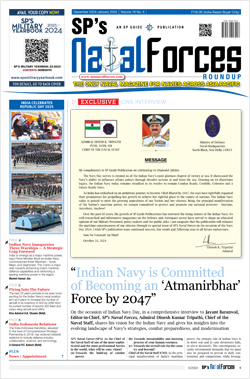INDIAN ARMED FORCES CHIEFS ON OUR RELENTLESS AND FOCUSED PUBLISHING EFFORTS

The insightful articles, inspiring narrations and analytical perspectives presented by the Editorial Team, establish an alluring connect with the reader. My compliments and best wishes to SP Guide Publications.

"Over the past 60 years, the growth of SP Guide Publications has mirrored the rising stature of Indian Navy. Its well-researched and informative magazines on Defence and Aerospace sector have served to shape an educated opinion of our military personnel, policy makers and the public alike. I wish SP's Publication team continued success, fair winds and following seas in all future endeavour!"

Since, its inception in 1964, SP Guide Publications has consistently demonstrated commitment to high-quality journalism in the aerospace and defence sectors, earning a well-deserved reputation as Asia's largest media house in this domain. I wish SP Guide Publications continued success in its pursuit of excellence.
- MoD initiates comprehensive review of Defence Acquisition Procedure 2020, pushes for defence reforms
- G7: The Swansong
- Kalinga Connect: South Asia to Polynesia
- Advanced MRSAM for India for a greater firepower
- Must Credit DRDO for Operation Sindoor, now what is next for defence R&D?
- Operation Sindoor | Day 2 DGMOs Briefing
- Operation Sindoor: Resolute yet Restrained
LEAD STORY
China’s Strategy of ‘Informationised and Intelligent’ Warfare
China’s Informationised War doctrine looks to impose significant costs on an adversary, even one that is conventionally superior, by targeting its command, control, communications, computers, intelligence, surveillance and reconnaissance (C4ISR) network and civilian computer networks
 | The Author was the Flag Officer Commanding-in-Chief, Southern Naval Command when he retired on November 30, 2021. He is a Navigation and Direction specialist. He was also the Director General Naval Operations and the Chief of Personnel, Indian Navy. |

China periodically announces major shifts in its military strategy through ‘Military Strategic Guidelines’ (MSGs) which dictate the tactics, equipment, training and manpower requirements to achieve the stated strategy. The PLA defines strategic guidelines as the ‘core and collected embodiment of strategy’, which contain ‘the programme and principles for planning and guiding the overall situation of war in a given period’. For the PLA, the concept of MSGs most closely approximates a National Military Strategy. As per authoritative Chinese sources, MSGs have four components: first, the identification of the strategic opponent based on China’s security environment and perceived threat to China’s national interests; second, the ‘primary strategic direction’, which refers to the geographic centre of gravity that will decisively shape the overall conflict as well as military deployments and preparations; third, the ‘basis for preparations for military struggle’, which describe the form of war or operations likely to be waged and hence the platforms and weapon systems required; and fourth, the ‘basic guiding thought’ for the use of military force or the general operational principles to be applied in conflict. The evolution of strategy occurs through ‘core concepts’ propounded by the Party General Secretary and Chairman of the Central Military Commission (CMC) (both posts normally held by the President of China) in speeches at the National Party Congress, which later become ‘strategic guiding thoughts’ or ‘strategic guiding ideology’ for the PLA. These thoughts are thereafter written into MSGs and then implemented through planning, acquisitions and resource allocations.
Integration of Technology in Warfare
One of the most notable shifts in China’s Military Strategy over the past four decades, especially in the 21st century, has been its embrace of technology in waging warfare. This has been a remarkable change from Mao’s earlier strategy of ‘People’s War’, which was based on manpower intensive guerrilla warfare and wholesale mobilisation of the Chinese people to repel an enemy. Though the term ‘People’s War’ has not been replaced due to political compulsions, its meaning has been subtly shifted to give primacy to technology, while retaining the importance of civil-military fusion to bring the country’s Comprehensive National Power (CNP) to bear upon an enemy. This shift actually started in the late 1980s after China’s lack of success in the Sino-Vietnam War in 1979 exposed the hollowness of its manpower-intensive army. Detailed introspection over a decade at the apex level led to the issue of the MSG of winning ‘Local/Limited Wars under Modern Conditions’ in 1988.
China today looks for ‘Information Dominance’ in war with graduation of their operational doctrine to ‘information dominance, precision strikes on strategic points and integrated joint operations’ to gain victory
The strategy was then further modified to winning ‘Local Wars under Modern Hitech Conditions‘ (LWUMHTC) in 1992, in the wake of the technological superiority demonstrated by the US and Western forces while successfully prosecuting theFirst Gulf War against Iraq (1990-91). According to PLA military theorists, LWUMHTC would be characterised by: limited geographical scope and political objectives; short duration; high intensity operational tempo; high mobility and speed (manoeuvre warfare); high lethality of weapons; high resource consumption requiring efficient logistics support; high battlefield transparency; C3I intensive nonlinear battlefield; multidimensional combat (land, air, sea, sub-surface, space, informational); and joint operations. The war envisaged under this doctrine envisaged the use of fewer but elite troops, more flexibility, greater surprise, more trans-regional air mobility, long range raids (strikes), vertical envelopment and surgical operations. Precision-guided munitions, increase in non-nuclear (conventional) lethality and extensive use of advanced technology, especially C4I (Command, Control, Communications, Computers and Intelligence) was also envisaged.
The ICT revolution and the Second Gulf War (2003-11) prompted continued Chinese discourse on the Revolution in Military Affairs (RMA), and they were convinced that unless they embraced technology on an even greater scale and incorporated it in their military strategy, they would not be able to prevail over their main adversary (the United States) in any future conflict. As a consequence, in 2004, China adopted the strategy of winning ‘Local Wars under Conditions of Informationisation’. ‘Informationisation’ is an awkward translation of the Chinese term ‘xinxihua’, which means ‘the application of information technology’. To achieve this new guideline, the timelines of a three-step development strategy for modernising China’s national defence and armed forces was enunciated in 2006 - the first step being to lay a solid foundation by 2010; the second to make major progress by around 2020; and the third to reach the strategic goal of building informationised armed forces capable of winning informationised wars by the mid twenty-first century.
What is Informationised Warfare
In the Chinese concept, informationised warfare is an offensive concept and implies three types of use of information as it pertains to the enemy - first, at the broadest level, knowledge of the enemy’s social, political and economic structure; secondly, in a narrower sense, it denotes precise knowledge of the enemy’s assets and his command and control structure; thirdly, at the narrowest level, it simply pertains to the enemy’s cyber space. These three types of information constitute six types of information warfare - propaganda war; the physical destruction of the enemy’s assets through long range precision strikes; creating military deception; electronic warfare; computer network warfare; and hacking into the enemy’s cyber world. Information in cyberspace has the highest importance in informationised warfare due to the increasing digitisation of national governance systems, considered by the Chinese as a country’s Achilles’ heel, and the ability to paralyse or destroy it through cyber warfare,though precision strike technologies are equally important.
Thus, the Informationised War doctrine looks to impose significant costs on an adversary, even one that is conventionally superior, by targeting its command, control, communications, computers, intelligence, surveillance and reconnaissance (C4ISR) network and civilian computer networks. Safeguarding own C4ISR and civilian networks is an essential part of informationised warfare. China is convinced that it is information that determines international relations and the outcome of modern war and only a state with unrestricted inflow of information and the ability to restrict the outflow of its own information will win a modern war. This is based on the assumption that once a state has complete and accurate information about the opponent, it can win the war without fighting – an ancient precept articulated by Sun Zi – which has now been termed as ‘information deterrence’. Chinese military thinkers also believe that this is a more affordable strategy than a force-onforce competition with the US.
China’s strategy of Information Dominance is a 24x7 operation, which continues, both in war and peace through a sophisticated and complex system, and requires a ‘whole of nation’ approach to counter
China’s most recent military strategy, promulgated in 2015, has been slightly revised to winning ‘Informationised Local Wars, Highlighting Maritime Military Struggle’, as information is now seen as playing a ‘leading role’ in warfare, instead of only being an ‘important condition’. The new strategy also highlights the importance of the maritime dimension for China, though that aspect is not being discussed in this article. The 2015 strategy highlighted that ‘An “information society” has come into being and the Revolution in Military Affairs has reached a new stage, with long-range, precise, stealthy and unmanned weapons and equipment becoming increasingly sophisticated. Outer space and cyber space have become the new commanding heights of competition among all parties and the form of war is accelerating its evolution to informationisation, causing world powers to adjust their national security strategies and defence policies and speeding up their military transformation and force restructurings.’ Consequently, China today looks for ‘Information Dominance’ in war with graduation of their operational doctrine from ‘integrated operations and precise strikes to subdue the enemy’ to ‘information dominance, precision strikes on strategic points and integrated joint operations’ to gain victory. The 2015 strategy envisages enhancing capabilities of its own operations based on integrating a wide range of operational forces into a seamless integrated joint operational system through secure joint information systems.
Moving towards Informationised and Intelligent Warfare
China most recent Defence White Paper issued in July 2019, postulates that ‘war is evolving in form towards informationised warfare and intelligent warfare is on the horizon’. The Paper also stated that global military competition was intensifying due to the onset of new technologies such as Artificial Intelligence, Machine Learning, Big Data Analytics, Cloud Computing and the Internet of Things. It recognised ‘technological surprise’ in warfare as a prime risk. It also acknowledged that the PLA was yet to complete the task of mechanisation and informationisation, thereby revising the timeline for achieving this concept to - generally achieve mechanisation by 2020 with significantly enhanced informationisation and greatly improved strategic capabilities; complete the modernisation of national defence and the military (theory, organisational structure, military personnel, weaponry and equipment) by 2035; and transform the people’s forces into world class forces by the mid-21st century.
Since China’s military strategic guidelines dictate its weapon and sensor procurement processes, it is no surprise that it has been investing heavily in all the key battlefield technologies identified in its strategic guidelines in a focussed and time-bound manner. The fact that Chinese weapon systems have progressively become more sophisticated and reliable has been acknowledged by the US Office of Naval Intelligence (ONI), which has stated that the PLA Navy’s ships, submarines and aircraft are today almost comparable to advanced navies, in terms of weapon and sensor capability, design aspects and material quality. PLAN also outmatches every regional navy in Asia, and in the past few years, has surpassed the US Navy in numbers of major combatants. The US Congressional Research Service, in its March 2022 report to the US Congress on China’s Naval Modernisation has informed that in 2021 the PLAN had 348 surface combatants, as compared to the US Navy’s 297 combatants. ONI also projected that the PLAN will have 420 major combatants by 2025 and 460 by 2030. In fact, the US today acknowledges that the PLAN poses a major challenge to their ability to maintain wartime sea control in ocean areas of the Western Pacific – the first such challenge posed to the US Navy since the end of the Cold War.
Training and Development of Human Resources
China has also placed emphasis on improving the PLA’s human resource to meet the requirements of hi-tech modern and informationised warfare. A major revamp of training was undertaken in 1999 to enhance PLA training to world class standards, with emphasis on training in science and technology, and information engineering. In 2000, to take advantage of scientific and technological advances, China implemented the ‘Strategic Project for Talented People’ by announcing a scheme to attract high calibre and talented individuals in defence-related science and technology. The project was further strengthened in 2004 with the aim of making ‘remarkable improvement in the quality of military personnel’ by 2010. In July 2007 the CMC also promulgated the Provisions of the Armed Forces on Attracting and Retaining High Levels of Specialised Technical Personnel. Under this scheme, talented individuals in science disciplines can join the PLA and carry out R&D in their respective fields. Bright personnel are also sponsored for courses of education and doctorates at the best western universities, some of whom have also been accused of stealing data and technologies from western laboratories. In 2015, China announced that the PLA would continue with the strategic project for talented people, perfect human resource management, continue to reform military training institutions and improve the training system ‘triad’ comprising institutional education, unit training and military professional education to meet the demands of informationised warfare.
The recent conflict in Ukraine has highlighted the importance of battle-field transparency, situational awareness and intelligence about the adversary, which has been reportedly facilitated for Ukraine by the West. This detailed information, supported by precision strikes by advanced unmanned and manned weapon systems has worked to the detriment of Russia, which has suffered disproportionate casualties, especially of its battle-tanks, aircraft and warships, against a much weaker adversary. China would have looked carefully at the lessons to be imbibed from this conflict, as should we, and would already be in the process of further refining its strategy for ‘informationised and intelligent’ warfare, which it has been presciently following over the last two decades.
Conclusion
India needs to note this fact very carefully, as it today faces an adversary which has invested heavily in communication, intelligence, satellite surveillance, reconnaissance, networking, EW, information warfare assets and artificial intelligence, besides possessing the entire array of advanced manned and unmanned platforms. Its indigenous satellite navigation systems and communication networks, as also the fact that Chinese society itself is behind a highly regulated ‘Great Firewall’, makes their cyberspace difficult to penetrate. China’s strategy of Information Dominance is a 24x7 operation, which continues, both in war and peace through a sophisticated and complex system, and requires a ‘whole of nation’ approach to counter. While technology alone will not prevail on the battlefield, ‘technological surprise’ can prove to be very costly, as Russia has learnt to its detriment. India has taken nascent steps in the field of cyber security and space, but much more needs to be done in concert with all agencies dealing with these issues in our country in order to synergise efforts to safeguard our C4ISR and civilian networks from cyber-attacks. India has the advantage of superior human resources in information technology, which needs to be used gainfully for our national security. Even more importantly, since technology is evolving rapidly, there is a pressing need to issue a national strategy and roadmap for imbibing the latest technology in defence, as China has done, so that there is a top-down direction to work towards preventing a ‘technical surprise’ by our adversary in the future.





